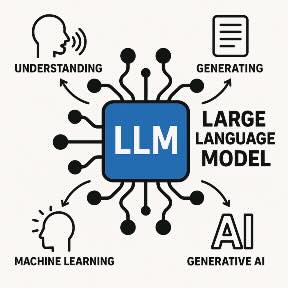Unpacking LLMs
Why Algorithmic Understanding is the Next Frontier
"We're currently accelerating AI capabilities through sheer scale. But to build truly reliable and ethical systems, we need to pause, understand the underlying algorithms, and appreciate the human implications. It's about the quality of intelligence, not just the quantity of data."— Nadina D. Lisbon
Hello Sip Savants! 👋🏾
Recent developments, such as DeepSeek R1 demonstrating strong performance with significantly reduced training costs, and ongoing discussions about AI's growing energy demands (potentially consuming two-thirds of the UK's annual water usage by 2027!), indicate a pivotal moment in AI research. The emphasis is shifting from simply "larger models" to "smarter models". A new paper, "We Need An Algorithmic Understanding of Generative AI," proposes a systematic framework called AlgEval to address this critical requirement by promoting a deeper examination of the actual algorithms LLMs learn and employ to solve problems.
3 Tech Bites
⚙️ Beyond Opaque Models
Traditionally, interpretability efforts for LLMs have focused on isolated mechanisms or low-level circuit analysis. AlgEval advocates for a more comprehensive "algorithmic understanding," moving beyond just what happens to how it happens, by uncovering the step-by-step procedures LLMs acquire. This approach is comparable to comprehending the "vocabulary and grammar" of an LLM's computational process.
🔋 Addressing Scaling Limitations
While increasing the size of LLMs has produced impressive outcomes, the paper contends that this strategy faces constraints due to rising computational expenses and diminishing returns, alongside substantial environmental consequences. Grasping the actual algorithms LLMs learn provides a sustainable alternative to continuously expanding data and computational power, potentially leading to more efficient training and lower emissions.
🔬 Observing Algorithms in Practice
A case study involving graph navigation tasks with Llama-3.1 models (8B and 70B parameters) uncovered that even large LLMs do not consistently use classic search algorithms such as Breadth-First Search (BFS) or Depth-First Search (DFS). Instead, their internal processing appears to involve an incremental shift in attention and a gradual separation of node representations, suggesting an adaptive strategy rather than an exhaustive search. This highlights the importance of algorithmic evaluation to truly understand how these models approach problem-solving.
5-Minute Strategy
🧠 Analyze an LLM's Problem-Solving Approach
Select a straightforward task: Choose an LLM task with a clear, verifiable outcome that can be achieved through an algorithmic process (e.g., goal-directed navigation on deterministic graphs).
Propose algorithmic methods: Based on established algorithms, formulate hypotheses about how the LLM might solve the task. For example, when searching a graph, consider classical search algorithms like Breadth-First Search (BFS), Dijkstra, or Depth-First Search (DFS).
Examine the output trace: Observe the LLM's output for several instances. Does it reveal intermediate steps? Can you infer a sequence of operations?
Identify core operations: Even without advanced tools, consider what "basic operations" the LLM appears to be performing (e.g., comparing elements, moving elements, retrieving information from memory). This initial, high-level analysis is crucial for beginning to understand the algorithmic structure.
Compare and refine: Does the observed problem-solving approach align with any of your initial hypotheses? If not, what new hypotheses emerge regarding how the LLM addresses the problem?
Credit : GitHub
1 Big Idea
💡 The Human Aspect of Algorithmic AI: Trust, Ethics, and Environmental Impact
The drive for an algorithmic understanding of generative AI extends beyond technical proficiency; it is deeply connected to human concerns such as trust, adherence to standards, and environmental responsibility.
When LLMs operate as opaque systems, prioritizing performance through scaling, their internal decision-making remains unclear. This lack of clarity directly affects our confidence in their outputs, particularly in critical applications. Without understanding how an LLM reaches a conclusion, ensuring compliance with evolving AI regulations becomes a significant challenge.
Furthermore, the immense computational and environmental burdens of training and operating increasingly large models, without a clear grasp of their inherent efficiency, are unsustainable. AlgEval offers a path to mitigate these issues by enhancing transparency and enabling the detection and reduction of algorithmic bias at a foundational level.
By understanding the "algorithmic vocabulary and grammar" of LLMs, we can develop more efficient architectures, create data-efficient training methods, and potentially decrease the environmental footprint linked to repeated errors and interactions. This shift towards a principled comprehension of underlying computations not only promises more reliable and robust AI systems but also ensures that the rapid progress of generative AI aligns with ethical considerations and environmental sustainability. For further reading on AI ethics, explore articles like "The Ethical AI Debate: Balancing Innovation and Responsibility"¹.
P.S. If you found these AI insights valuable, a contribution to the Brew Pot helps keep the future of work brewing.
P.P.S. Know someone else who could benefit from a sip of CRM wisdom? Share this newsletter and help them brew up stronger customer relationships!
Resources
Oliver Eberle, Thomas McGee, Hamza Giaffar, Taylor Webb, Ida Momennejad. "Position: We Need An Algorithmic Understanding of Generative AI". arXiv:2507.07544v1, 10 Jul 2025.
Sip smarter, every Tuesday. (Refills are always free!)
Cheers,
Nadina
Host of TechSips with Nadina | Chief Strategy Architect ☕️🍵


